Amniotic membrane transplantation for acute ocular burns
- PMID: 36047788
- PMCID: PMC9435439
- DOI: 10.1002/14651858.CD009379.pub3
Amniotic membrane transplantation for acute ocular burns
Abstract
Background: Ocular surface burns can be caused by chemicals (alkalis and acids) or direct heat. One effect of the burn is damage to the limbal epithelial stem cells of the ocular surface with delayed re-epithelialisation, stem cell failure, and conjunctivalisation of the cornea. Amniotic membrane transplantation (AMT) performed in the acute phase (day 0 to day 7) following an ocular surface burn is claimed to reduce pain and accelerate healing. The surgery involves securing a layer of amniotic membrane (AM) to the eyelid margins as a patch to cover the entire ocular surface. However, there is debate about the severity of an ocular burn that may benefit from AMT and uncertainty of whether AMT improves outcomes.
Objectives: To compare the effect of AMT with medical therapy in the first seven days after an ocular surface burn, compared to medical therapy alone.
Search methods: We searched the Cochrane Central Register of Controlled Trials (CENTRAL; which contains the Cochrane Eyes and Vision Trials Register; 2021, Issue 9); Ovid MEDLINE; Ovid Embase; LILACS; the ISRCTN registry; ClinicalTrials.gov and the WHO ICTRP. We did not use any date or language restrictions in the electronic searches for trials. We last searched the electronic databases on 29 September 2021.
Selection criteria: We included randomised trials that compared an AMT applied in the first seven days following an ocular surface burn in addition to medical therapy with medical therapy alone. The outcome measures were failure of re-epithelialisation by day 21 post injury, visual acuity at final follow-up, corneal neovascularisation, symblepharon, time to re-epithelialisation and adverse effects.
Data collection and analysis: Two review authors independently screened search results, assessed the included studies for risk of bias and extracted relevant data. We contacted trial investigators for missing information. We summarised data using risk ratios (RRs) and mean differences (MDs) as appropriate.
Main results: We analysed two RCTs, but excluded individual patients who had been treated outside the acute phase in one of the studies (data provided by study authors). In total, 36 moderate burns from one RCT and 92 severe burns from two RCTs were evaluated separately. For both categories, the certainty of the evidence was downgraded principally as a result of high risks of performance and detection biases, and because of imprecision indicated by very wide confidence intervals. In addition, follow-up was insufficiently frequent to calculate time-to-epithelialisation precisely. Moderate severity ocular burns (Roper-Hall classification II-III) The relative risk of AMT on failure of epithelialisation by day 21 was 0.18 (0.02 to 1.31), and LogMAR visual acuity was 0.32 lower (0.55 to 0.09 lower) in the treatment group (i.e. better), suggesting a possible benefit of AMT. The GRADE assessment for failure of epithelialisation by day 21 was downgraded to very low due to the risk of bias and imprecision (very wide confidence intervals including no effect). The GRADE assessment for visual acuity at final follow-up was downgraded to low due to the risk of bias and imprecision (optimal information size not met). The relative effects of AMT on corneal neovascularisation (RR 0.56; 0.21 to 1.48), symblepharon (RR 0.41; 0.02 to 9.48) and time-to-epithelialisation (13 days lower; 26.30 lower to 0.30 higher) suggest possible benefit of AMT, but the wide confidence intervals indicate that both harm and benefit are possible. GRADE assessments for these outcomes were once again downgraded to very low due to the risk of bias and imprecision. Since adverse effects are rare, the small sample would have fewer occurrences of rare but potentially important adverse effects. The GRADE assessment for adverse effects was therefore considered to be low. Severe ocular burns (Roper-Hall classification IV) The relative risk of AMT on failure of epithelialisation by day 21 was 1.03 (0.94 to 1.12), and LogMAR visual acuity was 0.01 higher (0.29 lower to 0.31 higher) in the treatment group (i.e, worse), indicating no benefit of AMT. GRADE assessments for failure of epithelialisation by day 21 and final outcomes were downgraded to low. The relative effects of AMT on corneal neovascularisation (RR 0.84; 0.66 to 1.06), symblepharon (RR 0.89; 0.56 to 1.42) and time-to-epithelialisation (1.66 days lower; 11.09 lower to 7.77 higher) may include both benefit and harm. GRADE assessments for corneal neovascularisation, symblepharon and time-to-epithelialisation were downgraded to low due to risk of bias and imprecision. For adverse effects, the GRADE assessment was downgraded to low, reflecting the small sample sizes in the RCTs.
Authors' conclusions: There is uncertain evidence to support the treatment of moderate acute ocular surface burns with AMT in addition to standard medical therapy as a means of preventing failure of epithelialisation by day 21, improving visual outcome and reducing corneal neovascularisation, symblepharon formation and time-to-epithelialisation. For severe burns, the available evidence does not indicate any significant benefit of treatment with AMT.
Copyright © 2022 The Cochrane Collaboration. Published by John Wiley & Sons, Ltd.
Conflict of interest statement
GC: None known. CB: None known. ST: None known.
Figures
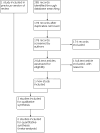




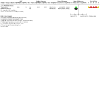

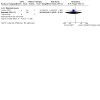


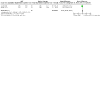
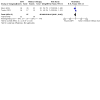
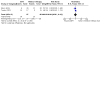
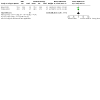
Update of
-
Amniotic membrane transplantation for acute ocular burns.Cochrane Database Syst Rev. 2012 Sep 12;2012(9):CD009379. doi: 10.1002/14651858.CD009379.pub2. Cochrane Database Syst Rev. 2012. Update in: Cochrane Database Syst Rev. 2022 Sep 1;9:CD009379. doi: 10.1002/14651858.CD009379.pub3. PMID: 22972141 Free PMC article. Updated. Review.
Similar articles
-
Amniotic membrane transplantation for acute ocular burns.Cochrane Database Syst Rev. 2012 Sep 12;2012(9):CD009379. doi: 10.1002/14651858.CD009379.pub2. Cochrane Database Syst Rev. 2012. Update in: Cochrane Database Syst Rev. 2022 Sep 1;9:CD009379. doi: 10.1002/14651858.CD009379.pub3. PMID: 22972141 Free PMC article. Updated. Review.
-
Folic acid supplementation and malaria susceptibility and severity among people taking antifolate antimalarial drugs in endemic areas.Cochrane Database Syst Rev. 2022 Feb 1;2(2022):CD014217. doi: 10.1002/14651858.CD014217. Cochrane Database Syst Rev. 2022. PMID: 36321557 Free PMC article.
-
Laser-assisted subepithelial keratectomy (LASEK) versus photorefractive keratectomy (PRK) for correction of myopia.Cochrane Database Syst Rev. 2016 Feb 22;2(2):CD009799. doi: 10.1002/14651858.CD009799.pub2. Cochrane Database Syst Rev. 2016. PMID: 26899152 Free PMC article. Review.
-
Evaluation of amniotic membrane transplantation as an adjunct to medical therapy as compared with medical therapy alone in acute ocular burns.Ophthalmology. 2005 Nov;112(11):1963-9. doi: 10.1016/j.ophtha.2005.05.022. Epub 2005 Sep 29. Ophthalmology. 2005. PMID: 16198422 Clinical Trial.
-
Non-pharmacological interventions for preventing delirium in hospitalised non-ICU patients.Cochrane Database Syst Rev. 2021 Jul 19;7(7):CD013307. doi: 10.1002/14651858.CD013307.pub2. Cochrane Database Syst Rev. 2021. PMID: 34280303 Free PMC article.
Cited by
-
Advances in Extracellular-Vesicles-Based Diagnostic and Therapeutic Approaches for Ocular Diseases.ACS Nano. 2024 Aug 27;18(34):22793-22828. doi: 10.1021/acsnano.4c08486. Epub 2024 Aug 14. ACS Nano. 2024. PMID: 39141830 Free PMC article. Review.
-
Composite Hydrogel Modulates Intrinsic Immune-Cascade Neovascularization for Ocular Surface Reconstruction after Corneal Chemical Injury.Gels. 2023 Aug 22;9(9):676. doi: 10.3390/gels9090676. Gels. 2023. PMID: 37754358 Free PMC article.
-
Sequelae of carbide-related thermo-chemical injury: A retrospective analysis.Indian J Ophthalmol. 2023 Sep;71(9):3192-3197. doi: 10.4103/IJO.IJO_57_23. Indian J Ophthalmol. 2023. PMID: 37602607 Free PMC article.
-
A Biosynthetic Alternative to Human Amniotic Membrane for Use in Ocular Surface Surgery.Transl Vis Sci Technol. 2024 May 1;13(5):3. doi: 10.1167/tvst.13.5.3. Transl Vis Sci Technol. 2024. PMID: 38696180 Free PMC article.
-
Frontiers in the Etiology and Treatment of Preterm Premature Rupture of Membrane: From Molecular Mechanisms to Innovative Therapeutic Strategies.Reprod Sci. 2024 Apr;31(4):917-931. doi: 10.1007/s43032-023-01411-9. Epub 2023 Nov 21. Reprod Sci. 2024. PMID: 37989803 Review.
References
References to studies included in this review
Eslani 2019 {published data only (unpublished sought but not used)}
-
- Eslani M, Baradaran-Rafii A, Cheung AY, Kurji KH, Hasani H, Djalilian AR, et al. Amniotic membrane transplantation in acute severe ocular chemical injury: a randomized clinical trial. American Journal of Ophthalmology 2019;199:209-15. - PubMed
Tandon 2011 {published and unpublished data}
-
- Tandon R, Gupta N, Kalaivani M, Sharma N, Titiyal JS, Vajpayee RB. Amniotic membrane transplantation as an adjunct to medical therapy in acute ocular burns. British Journal of Ophthalmology 2011;95(2):199-204. - PubMed
References to studies excluded from this review
Arora 2005 {published data only}
-
- Arora R, Mehta D, Jain V. Amniotic membrane transplantation in acute chemical burns. Eye 2005;19(3):273-8. - PubMed
López‐García 2006 {published data only}
-
- López-García JS, Rivas L, García-Lozano I, Murube J. Analysis of corneal surface evolution after moderate alkaline burns by using impression cytology. Cornea 2006;25(8):908-13. - PubMed
López‐García 2007 {published data only}
-
- López-García JS, Rivas Jara L, García-Lozano I, Murube J. Histopathologic limbus evolution after alkaline burns. Cornea 2007;26(9):1043-8. - PubMed
Meller 2000 {published data only}
-
- Meller D, Pires RT, Mack RJ, Figueiredo F, Heiligenhaus A, Park WC, et al. Amniotic membrane transplantation for acute chemical or thermal burns. Ophthalmology 2000;107(5):980-9. - PubMed
Muraine 2001 {published data only}
-
- Muraine M, Descargues G, Franck O, Villeroy F, Toubeau D, Menguy E, et al. Amniotic membrane graft in ocular surface disease. Prospective study with 31 cases [La greffe de membrane amniotique dans les pathologies oculaires de surface. Etude prospective a partir de 31 cas]. Journal Francais d' Opthalmologie 2001;24(8):798-812. - PubMed
Sharma 2016 {published data only (unpublished sought but not used)}
-
- Sharma N, Singh D, Maharana PK, Kriplani A, Velpandian T, Pandey RM, et al. Comparison of amniotic membrane transplantation and umbilical cord serum in acute ocular chemical burns: a randomized controlled trial. American Journal of Ophthalmology 2016;168:157-63. - PubMed
Tamhane 2005 {published data only (unpublished sought but not used)}
-
- Tamhane A, Vajpayee RB, Biswas NR, Pandey RM, Sharma N, Titiyal JS, et al. Evaluation of amniotic membrane transplantation as an adjunct to medical therapy as compared with medical therapy alone in acute ocular burns. Ophthalmology 2005;112(11):1963-9. - PubMed
Additional references
Ang 2021
Bagley 2006
-
- Bagley DM, Casterton PL, Dressler WE, Edelhauser HF, Kruszewski FH, McCulley JP, et al. Proposed new classification scheme for chemical injury to the human eye. Regulatory Toxicology and Pharmacology 2006;45(2):206-13. - PubMed
Ballen 1964
-
- Ballen PH. Treatment of chemical burns of the eye. Eye, Ear, Nose and Throat Monthly 1964;43:57-61. - PubMed
Baum 2002
-
- Baum J. Thygeson lecture. Amniotic membrane transplantation: why is it effective? Cornea 2002;21(4):339-41. - PubMed
Bizrah 2019
Cotsarelis 1989
-
- Cotsarelis G, Cheng SZ, Dong G, Sun TT, Lavker RM. Existence of slow-cycling limbal epithelial basal cells that can be preferentially stimulated to proliferate: implications on epithelial stem cells. Cell 1989;57(2):201-9. - PubMed
Davanger 1971
-
- Davanger M, Evensen A. Role of the pericorneal papillary structure in renewal of corneal epithelium. Nature 1971;229(5286):560-1. - PubMed
Dua 2001
Dua 2020
Fung 2019
-
- Fung SS, Stewart RM, Dhallu SK, Sim DA, Keane PA, Wilkins MR, et al. Anterior segment optical coherence tomographic angiography assessment of acute chemical injury. American Journal of Ophthalmology 2019;205:165-74. - PubMed
Glanville 2006
Gupta 2011
-
- Gupta N, Kalaivani M, Tandon R. Comparison of prognostic value of Roper Hall and Dua classification systems in acute ocular burns. British Journal of Ophthalmology 2011;95(2):194-8. - PubMed
Haring 2016
-
- Haring RS, Sheffield ID, Channa R, Canner JK, Schneider EB. Epidemiologic trends of chemical ocular burns in the United States. JAMA Ophthalmology 2016;134(10):1119-24. - PubMed
Harun 2004
Higgins 2017
-
- Higgins JP, Altman DG, Sterne JA (editors). Chapter 8: Assessing risk of bias in included studies. Chapter 8: Assessing risk of bias in included studies. In: Higgins JP, Churchill R, Chandler J, Cumpston MS (editors), Cochrane Handbook for Systematic Reviews of Interventions version 5.2.0 (updated June 2017). Available from www.training.cochrane.org/handbook.
Kam 2019
Kim 2000
-
- Kim JS, Kim JC, Na BK, Jeong JM, Song CY. Amniotic membrane patching promotes healing and inhibits proteinase activity on wound healing following acute corneal alkali burn. Experimental Eye Research 2000;70(3):329-37. - PubMed
Kinoshita 1982
-
- Kinoshita S, Kiorpes TC, Friend J, Thoft RA. Limbal epithelium in ocular surface wound healing. Investigative Ophthalmology and Visual Science 1982;23(1):73-80. - PubMed
Klifto 2019
Kuckelkorn 1995a
-
- Kuckelkorn R, Kottek A, Schrage N, Reim M. Poor prognosis of severe chemical and thermal eye burns: the need for adequate emergency care and primary prevention. International Archives of Occupational and Environmental Health 1995;67(4):281-4. - PubMed
Kuckelkorn 1995b
-
- Kuckelkorn R, Schrage N, Reim M. Treatment of severe eye burns by Tenon-plasty. Lancet 1995;345(8950):657-8. - PubMed
Le 2018
Le 2019
Liu 2012
Loon 2009
-
- Loon SC, Tay WT, Saw SM, Wang JJ, Wong TY. Prevalence and risk factors of ocular trauma in an urban south-east Asian population: the Singapore Malay Eye Study. Clinical and Experimental Ophthalmology 2009;37(4):362-7. - PubMed
Macdonald 2009
-
- Macdonald EC, Cauchi PA, Azuara-Blanco A, Foot B. Surveillance of severe chemical corneal injuries in the UK. British Journal of Ophthalmology 2009;93(9):1177-80. - PubMed
Mamede 2012
-
- Mamede AC, Carvalho MJ, Abrantes AM, Laranjo M, Maia CJ, Botelho MF. Amniotic membrane: from structure and functions to clinical applications. Cell Tissue Research 2012;349(2):447-58. - PubMed
McCulley 1987
-
- McCulley JP. The Cornea: Scientific Foundation and Clinical Practice. 2nd edition. Boston: Little, Brown and Co, 1987.
Murdoch 1998
Nowell 2017
-
- Nowell CS, Radtke F. Corneal epithelial stem cells and their niche at a glance. Journal of Cell Science 2017;130(6):1021-5. - PubMed
Paolin 2016
Rao 1999
-
- Rao SK, Rajagopal R, Sitalakshmi G, Padmanabhan P. Limbal autografting: comparison of results in the acute and chronic phases of ocular surface burns. Cornea 1999;18(2):164-71. - PubMed
Ratnapalan 2011
-
- Ratnapalan S, Das L. Causes of eye burns in children. Pediatric Emergency Care 2011;27(2):151-6. - PubMed
RevMan Web 2022 [Computer program]
-
- Review Manager Web (RevMan Web) . Version 4.12.0. The Cochrane Collaboration, 2022. Available at revman.cochrane.org.
Roper‐Hall 1965
-
- Roper-Hall MJ. Thermal and chemical burns. Transactions of the Ophthalmological Society of the United Kingdom 1965;85:631-53. - PubMed
Sahay 2019
-
- Sahay P, Goel S, Maharana P K, Sharma N. Amniotic membrane transplantation in acute severe ocular chemical injury: a randomized clinical trial. American Journal of Ophthalmology 2019;205:202-3. - PubMed
Schünemann 2011
-
- Schünemann HJ, Oxman AD, Higgins JP, Vist GE, Glasziou P, Guyatt GH. Chapter 11: Presenting results and ‘Summary of findings' tables. In: Higgins JP, Green S (editors), Cochrane Handbook for Systematic Reviews of Interventions Version 5.1.0 (updated March 2011). The Cochrane Collaboration, 2011. Available from www.cochrane-handbook.org.
Shafto 1950
Sharma 2015
-
- Sharma N, Lathi SS, Sehra SV, Agarwal T, Sinha R, Titiyal JS, et al. Comparison of umbilical cord serum and amniotic membrane transplantation in acute ocular chemical burns. British Journal of Ophthalmology 2015;99(5):669-73. - PubMed
Sharma 2018
-
- Sharma N, Kaur M, Agarwal T, Sangwan VS, Vajpayee RB. Treatment of acute ocular chemical burns. Survey of Ophthalmology 2018;63(2):214-35. - PubMed
Shimazaki 1997
-
- Shimazaki K, Yang HY, Tsubota K. Amniotic membrane transplantation for ocular surface reconstruction in patients with chemical and thermal burns. Ophthalmology 1997;104(12):2068-76. - PubMed
Shortt 2007
-
- Shortt AJ, Secker GA, Munro PM, Khaw PT, Tuft SJ, Daniels JT. Characterization of the limbal epithelial stem cell niche: novel imaging techniques permit in vivo observation and targeted biopsy of limbal epithelial stem cells. Stem Cells 2007;25(6):1402-9. - PubMed
Smith 2004
Tseng 2004
-
- Tseng SC, Espana EM, Kawakita T, Di Pascuale MA, Li W, He H, et al. How does amniotic membrane work? Ocular Surface 2004;2(3):177-87. - PubMed
Vajpayee 2014
-
- Vajpayee RB, Shekhar H, Sharma N, Jhanji V. Demographic and clinical profile of ocular chemical injuries in the pediatric age group. Ophthalmology 2014;121(1):377-80. - PubMed
Wagoner 1997
-
- Wagoner MD. Chemical injuries of the eye: current concepts in pathophysiology and therapy. Survey of Ophthalmology 1997;41(4):275-313. - PubMed
Westekemper 2017
-
- Westekemper H, Figueiredo FC, Siah WF, Wagner N, Steuhl KP, Meller D. Clinical outcomes of amniotic membrane transplantation in the management of acute ocular chemical injury. British Journal of Ophthalmology 2017;101(2):103-7. - PubMed
Wong 2000
-
- Wong TY, Klein BE, Klein R. The prevalence and 5-year incidence of ocular trauma. The Beaver Dam Eye Study. Ophthalmology 2000;107(12):2196-202. - PubMed
Wong 2018
-
- Wong MY, Man RE, Gupta P, Sabanayagam C, Wong TY, Cheng CY, et al. Prevalence, subtypes, severity and determinants of ocular trauma: The Singapore Chinese Eye Study. British Journal of Ophthalmology 2018;102(2):204-9. - PubMed
Xiang 2005
-
- Xiang H, Stallones L, Chen G, Smith GA. Work-related eye injuries treated in hospital emergency departments in the US. American Journal of Industrial Medicine 2005;48(1):57-62. - PubMed
References to other published versions of this review
Clare 2011
Publication types
MeSH terms
LinkOut - more resources
Full Text Sources
Research Materials
Miscellaneous

